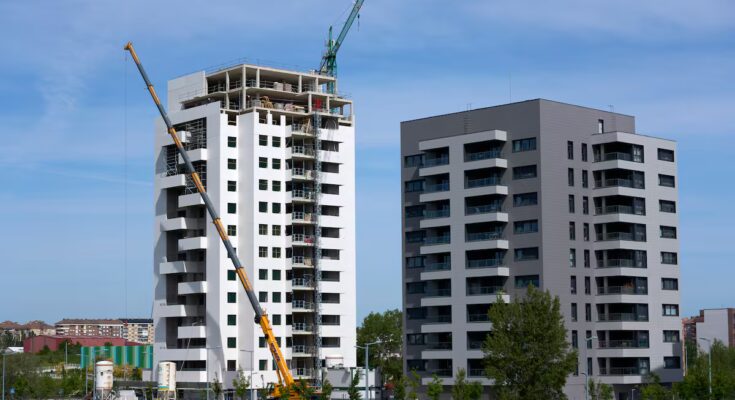The expectations placed on build to rent (BTR) are fading and voices are growing saying that this model, which consists of the promotion and construction of rental apartments, is more dead than alive. Or, at least, die. This is no small problem, as it compromises the increase in the supply of rental homes, which would ease the crisis.
This formula became consolidated in Spain around 2021, when promoters and investment funds, usually associated joint venture— announced the construction of thousands of new rental apartments managed by a professional operator.
But the numbers don’t add up, the math doesn’t add up. Alejandro Bermúdez, CEO of Atlas Real Estate Analytics, speaks of “a perfect storm of land, financing and construction, compounded by regulatory uncertainty and a growing lack of landlord-tenant protection.” The result: “It is very complicated to implement rental housing projects.” Colliers recalls that already in December 2023 it was predicted that the model would practically disappear. Since then there have been no more than a dozen new free housing developments earmarked for the BTR,” explains Antonio de la Fuente, general manager of the consultancy’s Living division.
An analysis prepared by the real estate data platform Atlas for EL PAÍS details the decline. In 2021, BTR’s planned private and public portfolio for 2025-2026 was 90,180 rental homes, both affordable and rent-free. In 2022 this number has risen to 102,560, especially thanks to the push of public projects such as Madrid’s Plan Vive. Of all these homes, just under 15,000 have been built today, or 14.5% of what was initially announced. Furthermore, those that were built cost more than expected.
Data shows that BTR, as designed, has slowed down. “Private developers have turned their buildings into housing for sale,” explains Bermúdez. The majority gave up on their initial goal and moved on to plan b. “The little residential land available is mainly used for the development of homes for sale, a segment that works very well and is not affected by the same regulatory uncertainties,” comments De la Fuente. Colliers estimates that investments in this segment went from 1,883 million euros in 2023 to 684 million in 2024 and 676 million until September this year. Very different numbers from those managed by the consultancy firm CBRE, which recorded 1,170 million euros between the first and third quarters of the year and which maintains, however, that the model is by no means exhausted.
Atlas data confirms that today there are 13,434 rental homes still operational, under construction, both by private developers and public administrations. The majority, 8,900, are located in the provinces of Madrid and Barcelona. That is, between those completed and those in progress, there are 28,434 apartments, very far from the initial target.
What happened so that in just a few years this model stopped being an important lever for increasing the rental fleet? Alejandro Bermúdez cites land prices as one of the biggest bottlenecks. In large cities it rarely goes below 1,500 euros per building square meter and, in some cases, it exceeds 3,000. “With land representing around 35% or 40% of the cost of the building, the sales price that developers would be expected to ask for is around 9,000 euros per square meter and its rental equivalent would be around 37.5 euros per square meter per month, an impractical threshold for the target demand of the BTR.” In case the developer already owns the land, he can build a large portfolio and sell it to the capital nucleus —institutional investor looking for low but very stable returns.
De la Fuente adds another major obstacle. “The returns investors require to develop new rental housing or invest in existing housing have increased.” And he cites two reasons: “For the increase in the profitability of government bonds, i.e. the risk-free profitability with which they can invest in Spain or Europe, and for the perceived risk towards rental housing due to regulatory instability towards owners.”
Regulation is one of the aspects most criticized by experts; They see it as primarily responsible for funds like Blackstone, Cerberus and others selling their portfolios. Although the reasons are different: “Good time to sell houses, large and stabilized portfolios, growing pressure on owners of rental houses that triggers alarms in managers and, finally, a certain fomo (acronym in English for the expression “fear of missing out”) in missing a good moment in which numerous sales of house portfolios are recorded”, says Bermúdez.
It is not decisive, but also the fact that financing today is much more expensive than during the financial euphoria that fueled the BTR – even though interest rates have fallen – and that construction costs have increased by more than 40% since 2020.
Jaime-Enrique Hugas, co-founder and one of the two CEOs of the promoter Conren Tramway, is categorical in stating that the build to rent in free accommodation in Barcelona he died. “The projects were very tied to profitability and if we add to this the regulation of rents, the sector can hardly do BTR,” says the director of this manufacturer, one of the main ones in Barcelona, which promotes the urban transformation of Mercedes, a project located in the old Mercedes-Benz factory in the Sant Andreu neighborhood. “We intended to build the BTR, but when the price regulation was implemented we were forced to change it business plan to homes for sale,” says Hugas.
Affordable rentals
When it comes to affordable construction, that which has prices lower than the free market and arises from public and private collaboration through the transfer of land under surface rights, things change, even if they are not excessively attractive, at least for the majority of investors. “Net returns are between 3% and 4% per year, lower than those of a sovereign bond with much higher (physical and reputational) risk,” they say on Atlas. For this reason the capital allocated to affordable rentals is nucleuswith low and stable yields.
In the case of Catalonia, “when it comes to sheltered housing, even if the returns are very low, you can continue to do it because there are more legal guarantees,” says Hugas. In this segment, the plans of several autonomous communities, such as Madrid, Catalonia, the Basque Country, Andalusia and the Valencian Community, foresee a wave of public-private collaboration at different paces. Atlas’ CEO believes that until all variables are rebalanced, “we will see greater conversion to sales, a geographic focus on Madrid and Barcelona, and public-private collaboration as the main avenue for affordable housing.”



